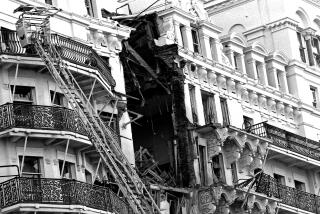Gibraltar Bomb Sought After IRA Deaths
- Share via
LONDON — Security forces in the British colony of Gibraltar searched Monday for explosives believed abandoned by three Irish Republican Army guerrillas who were killed by the forces as they attempted to flee across the frontier into neighboring Spain.
Speaking in a crowded House of Commons, British Foreign Secretary Geoffrey Howe declared that the killing of the IRA activists late Sunday had averted “a dreadful terrorist act.”
Apparently acting on a tip from the Spanish police, British security forces sighted the guerrillas as they passed into the British colony, a large military base at the tip of the Spanish peninsula. They placed the three under surveillance as they moved about the colony and then challenged them as they were about to leave.
According to Howe, the three were preparing to place a car bomb in front of the governor’s residence to be detonated during a weekly military parade scheduled there for today.
“Had a bomb exploded in the area, not only the 50 soldiers involved in the parade, but also a large number of civilians might well have been killed or injured,” Howe said.
The unit involved in the parade, the Royal Anglian Regiment, had only recently transferred to Gibraltar from Northern Ireland.
More than 2,600 people have died in Northern Ireland as a result of terrorist-related violence during the last two decades, but aside from brief, violent sorties onto the British mainland, the IRA has only occasionally tried to extend its terrorist campaign beyond the British Isles.
Those familiar with IRA activities noted that the organization in recent years has developed contacts with ETA, the Basque separatist guerrilla organization in Spain, and some suggest that ETA, which stands for Basque Homeland and Freedom, may have provided assistance to the three Gibraltar guerrillas.
A statement issued by the IRA in Belfast, Northern Ireland, confirmed that the three killed were “on active service.”
British security officials described two of the dead as among the most prominent members of the Irish guerrilla organization, which has waged a campaign of violence to end British rule in Northern Ireland since Britain granted independence to the Irish Republic in 1920.
Imprisoned for 10 Years
Mairead Farrell, 31, had served 10 years in prison for the 1976 bombing of a Belfast hotel and had been officially greeted with a standing ovation at a convention of the IRA’s political wing, Sinn Fein, after her release from jail two years ago.
In 1980, she led a hunger strike among women inmates in an attempt to win treatment as political prisoners for IRA members.
Daniel McCann, 30, was said to be a leading member of the IRA’s largest unit in Belfast. The third slain guerrilla was identified as Sean Savage, 24.
While Howe referred repeatedly to “military personnel” in his statement in Parliament, it is believed that the guerrillas were killed by elements of Britain’s elite Special Air Services and not by regular soldiers.
Witnesses said men in blue jeans first challenged the three as they walked toward the border, then began shooting as they attempted to run.
While initial accounts described a shoot-out, Howe later stated the three were unarmed.
No Bomb in Car
A white Renault car they had parked near the governor’s residence believed to be carrying the bomb was later found by security forces to be empty.
News reports that no bomb had been found coupled with Howe’s admission that the three dead people were unarmed sparked sporadic street violence in Roman Catholic neighborhoods of central Belfast on Monday evening, with police reporting bands of youths hijacking cars, then setting them on fire.
Despite the absence of explosives, Howe staunchly defended the security operation.
“The three people killed were actively involved in the planning and attempted execution of that (bombing) act,” he said.
Keys found on one of the bodies led security officials to a Ford Fiesta on the Spanish side of the border that contained three false passports, an alarm clock, electrical tape and wire.
Late Monday, Spanish and British security forces were conducting a search for a third car also believed to be involved in the guerrilla’s plans. That vehicle could contain explosives, they said.
More to Read
Sign up for Essential California
The most important California stories and recommendations in your inbox every morning.
You may occasionally receive promotional content from the Los Angeles Times.









